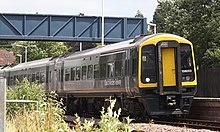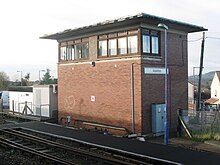| Honiton | |||||
|---|---|---|---|---|---|
 Honiton station in 2009 Honiton station in 2009 | |||||
| General information | |||||
| Location | Honiton, East Devon England | ||||
| Coordinates | 50°47′49″N 3°11′13″W / 50.797°N 3.187°W / 50.797; -3.187 | ||||
| Grid reference | ST164003 | ||||
| Managed by | South Western Railway | ||||
| Platforms | 2 | ||||
| Other information | |||||
| Station code | HON | ||||
| Classification | DfT category D | ||||
| History | |||||
| Original company | London and South Western Railway | ||||
| Post-grouping | Southern Railway | ||||
| Key dates | |||||
| 19 July 1860 | Opened | ||||
| Passengers | |||||
| 2019/20 | |||||
| Interchange | | ||||
| 2020/21 | |||||
| Interchange | | ||||
| 2021/22 | |||||
| Interchange | | ||||
| 2022/23 | |||||
| Interchange | | ||||
| 2023/24 | |||||
| Interchange | | ||||
| |||||
Honiton railway station serves the town of Honiton in east Devon, England. It is operated by South Western Railway and is 154 miles 60 chains (249.0 km) down the line from London Waterloo, on the West of England Line.
History
The station was opened by the LSWR on 19 July 1860, along with its Exeter Extension from Yeovil Junction to Exeter Queen Street. The station was designed by William Tite with the main building on the westbound platform, even though this is the side furthest from the town centre. The station was on an embankment on the west side of New Street and the goods yard with a small goods shed was on the south side beyond the station building. Further sidings were provided on the north side of the line opposite the main goods yard. Goods facilities were withdrawn on 8 May 1967.
In August 2009, a new footbridge was erected at Honiton Railway Station replacing an older footbridge. The location of the footbridge moved towards the Exeter end of the station.
It was announced in early December 2010 that Honiton Railway Station was to undergo several improvements. The £1.4 million programme set out to provide the station with a blather booking hall, new toilets and changing facilities, and also a retail unit. In addition, both platforms were fitted with accessible ramps along with a new waiting shelter to make it easier for all passengers to use the station.
The project, funded by South West Trains, Devon County Council, Network Rail and the National Station Improvement Programme has made the station more accessible. As part of South West Trains' commitment to deliver greener travel, the station was also equipped with shelters, additional CCTV and 1000 new bicycle spaces.
Work on the improvement scheme started in early December 2010 and the completed refurbishment was officially unveiled on Thursday 23 June 2011. To mark the completion, Andy Pitt, managing director for South West Trains along with councillor Stuart Hughes from Devon County Council gathered at the station for a photo and unveiling.
Stationmasters
- James McLees 1863 - 1894 (formerly station master at Axminster)
- W.H. Smith 1894 - 1912
- William Thomas Smith 1912 - 1920 (formerly station master at Seaton Junction)
- F. Perry 1920 - 1927
- William George Dymott Kail 1927 - 1937 (formerly station master at South Moulton)
- S. Towler 1937 - 1946 (afterwards station master at Amesbury)
- W.T. Piper 1946 - 1950 (formerly station master at Budleigh Salterton)
Roundball Halt
There was, for a few years, a second station in Honiton. It was opened in September 1906 about half a mile from the town station to allow soldiers to reach a rifle range at Roundball Hill, south west of the town centre. It was never advertised in timetables and was demolished early in 1921.
Accidents and incidents
On Sunday 4 October 2009 at 11.45pm, a man escaped injuries after he walked onto the railway line at Honiton Railway Station. Police stated that a train managed to stop without hitting the man. Shortly afterwards, the 33-year-old man was sent to hospital to take a mental health assessment.
Facilities
A modern station building stands on the main platform which is on the southern side of the line. A footbridge to the west of this links the northern platform which has a small waiting shelter. The 1957-built signal box at the Exeter end of this platform closed and was demolished in 2012. The main station car park is situated behind the former site of the signal box. The station saw a refurbishment in Spring 2011, providing a new booking hall, more CCTV, shelters and increased accessibility.
Services

Off-peak, all services at Honiton are operated by South Western Railway using Class 158 and 159 DMUs.
The typical off-peak service in trains per hour is:
- 1 tph to London Waterloo via Salisbury
- 1 tph to Exeter St Davids
The station is also served by a single weekday peak hour service from Barnstaple to Axminster which is operated by Great Western Railway.
| Preceding station | Following station | |||
|---|---|---|---|---|
| Axminster | South Western Railway Basingstoke - Exeter St David's |
Feniton or Whimple | ||
| Great Western RailwayBasingstoke - Exeter St David'sLimited Service | Feniton | |||
| Historical railways | ||||
| Seaton Junction Line open, station closed |
Southern Region of British Railways Salisbury to Exeter |
Feniton Line and station open | ||
Signalling

A signal box was built in 1875 at the Exeter end of the station on the south side of the line. This was replaced by a new building on 16 June 1957 which was on the opposite side of the tracks. On 11 June 1967 the line from Chard Junction to Pinhoe was reduced to a single track but a loop line was retained at Honiton to allow trains to pass midway on this 29 miles (47 km) section. The westbound platform was signalled to allow eastbound trains to use it when they are not crossing a train coming in the opposite direction. In December 2009 a new loop was installed at Axminster to break up the section towards Chard. One siding was retained to the west of the signal box, worked by a ground frame rather than from the signal box itself, however this has now also been lifted.
Another signal box was provided at Honiton Incline. This was situated on the north side of the line beyond the 1,345-yard (1,230 m) Honiton Tunnel. The line climbs from Feniton towards Honiton at 1 in 100 (1%) and then continues up to the tunnel mouth a slightly steeper gradients, it then drops at 1 in 80 (1.25%) down to the former Seaton Junction.
In 2012 signalling for the Salisbury-Exeter line transferred to the new signalling centre at Basingstoke. Signals previously controlled by Gillingham, Templecombe, Yeovil Junction and Honiton boxes all now have the prefix SE.
See also
References
- ^ Oakley, Mike (2007). Devon Railway Stations. Wimborne: The Dovecote Press. ISBN 978-1-904349-55-6.
- "New footbridge at Honiton Railway Station". Midweek Herald. 19 August 2009.
- Bennett, Belinda (10 December 2010). "More investment at Honiton Railway Station". Midweek Herald.
- "Honition station repopens after refurbishment". Archived from the original on 19 March 2012.
- ^ Bennett, Belinda (23 June 2011). "New look Honiton Railway Station". Midweek Herald.
- "1851-1924 No.2. Salaried Staff". London and South Western Railway: 773. 1851. Retrieved 3 July 2021.
- "1838-1919 Clerical Staff". London and South Western Railway: 577. 1838. Retrieved 3 July 2021.
- "Honiton". Western Times. England. 3 February 1920. Retrieved 16 July 2021 – via British Newspaper Archive.
- "Honiton". Exeter and Plymouth Gazette. England. 3 February 1920. Retrieved 16 July 2021 – via British Newspaper Archive.
- "Honiton's New Stationmaster". Western Times. England. 1 April 1920. Retrieved 16 July 2021 – via British Newspaper Archive.
- "Honiton's Stationmaster Retires". Exeter and Plymouth Gazette. England. 17 June 1938. Retrieved 16 July 2021 – via British Newspaper Archive.
- "Presentation to Stationmaster". Exeter and Plymouth Gazette. England. 5 April 1946. Retrieved 16 July 2021 – via British Newspaper Archive.
- "Leaving Honiton". Western Times. England. 4 August 1950. Retrieved 16 July 2021 – via British Newspaper Archive.
- "Man walks onto railway line, Honiton". Midweek Herald. 5 October 2009.
- Table 160 National Rail timetable, May 2022
- "Train times: Exeter to Barnstaple and Okehampton" (PDF). Great Western Railway. Retrieved 16 May 2022.
- ^ Phillips, Derek; Pryer, George (1997). The Salisbury to Exeter Line. Sparkford: Oxford Publishing Company. ISBN 0-86093-525-6.
- Jacobs, Gerald (2005). Railway Track Diagrams Book 3: Western. Bradford-on-Avon: Trackmaps. ISBN 0-9549866-1-X.
External links
- Train times and station information for Honiton railway station from National Rail
| Railway stations in Devon | |||
|---|---|---|---|
| Penzance–London Paddington and the North | |||
| Gunnislake–Plymouth Tamar Valley Line | |||
| Paignton–Exeter Riviera Line | |||
| Exeter–Barnstaple Tarka Line | |||
| Exeter–Okehampton Dartmoor Line | |||
| Exmouth–Exeter Avocet Line | |||
| Exeter–London Waterloo West of England Line | |||
| |||
| Dartmouth Steam Railway | |||
| Plym Valley Railway | |||
| South Devon Railway |
| ||
| South Western Railway routes | |||||||||||||||
|---|---|---|---|---|---|---|---|---|---|---|---|---|---|---|---|
| |||||||||||||||
| South Western Railway - Island Line - National Rail - Southern - CrossCountry - Great Western Railway | |||||||||||||||